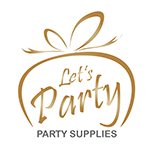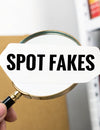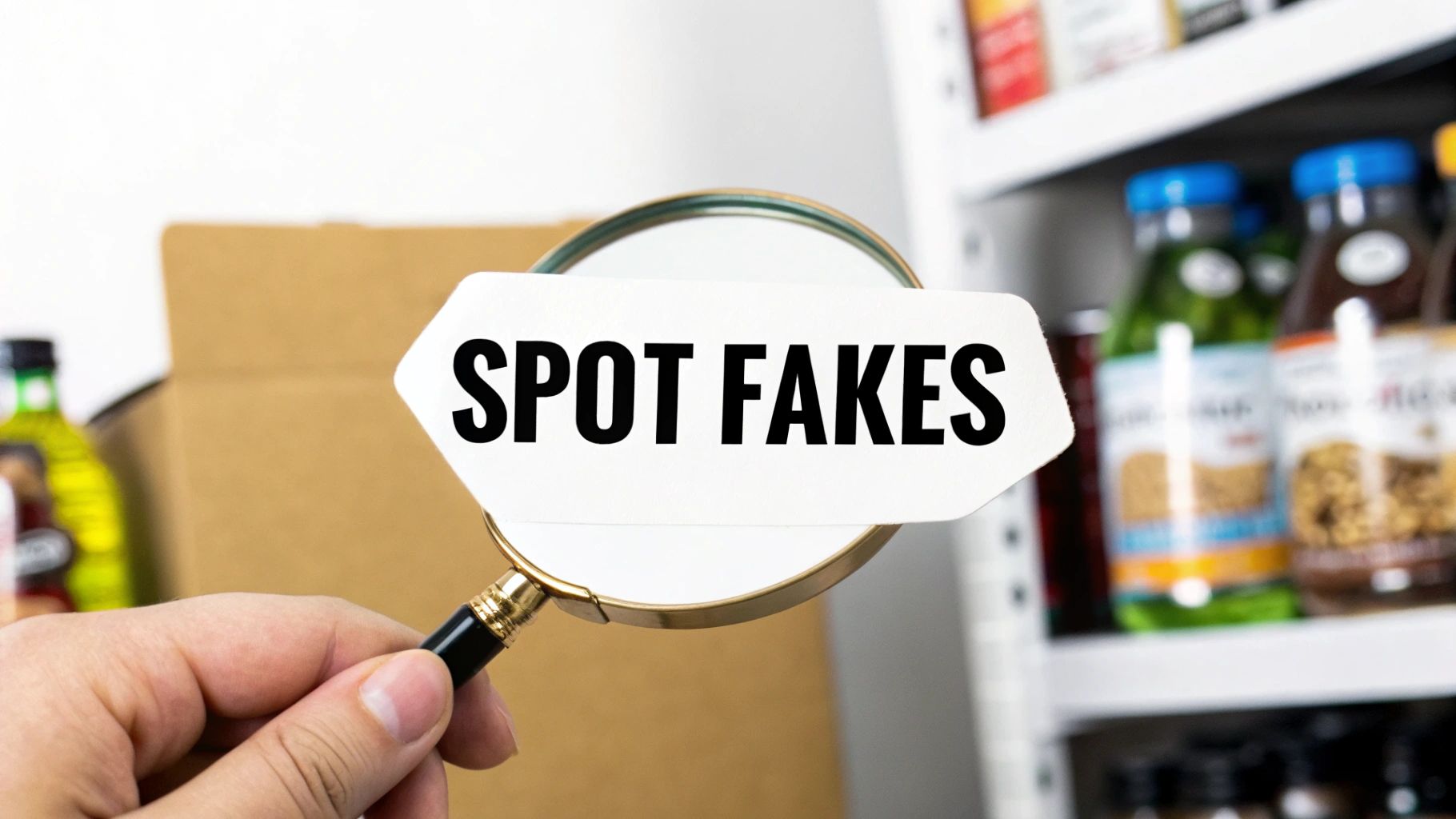
Spotting a fake often comes down to the little details—a flimsy box, a poorly stitched seam, or a serial number that leads nowhere. Learning how to identify counterfeit products is more than just a savvy shopping skill; it's a crucial defense against the risks that fakes pose to both your safety and your wallet.
The Hidden Dangers of Counterfeit Goods
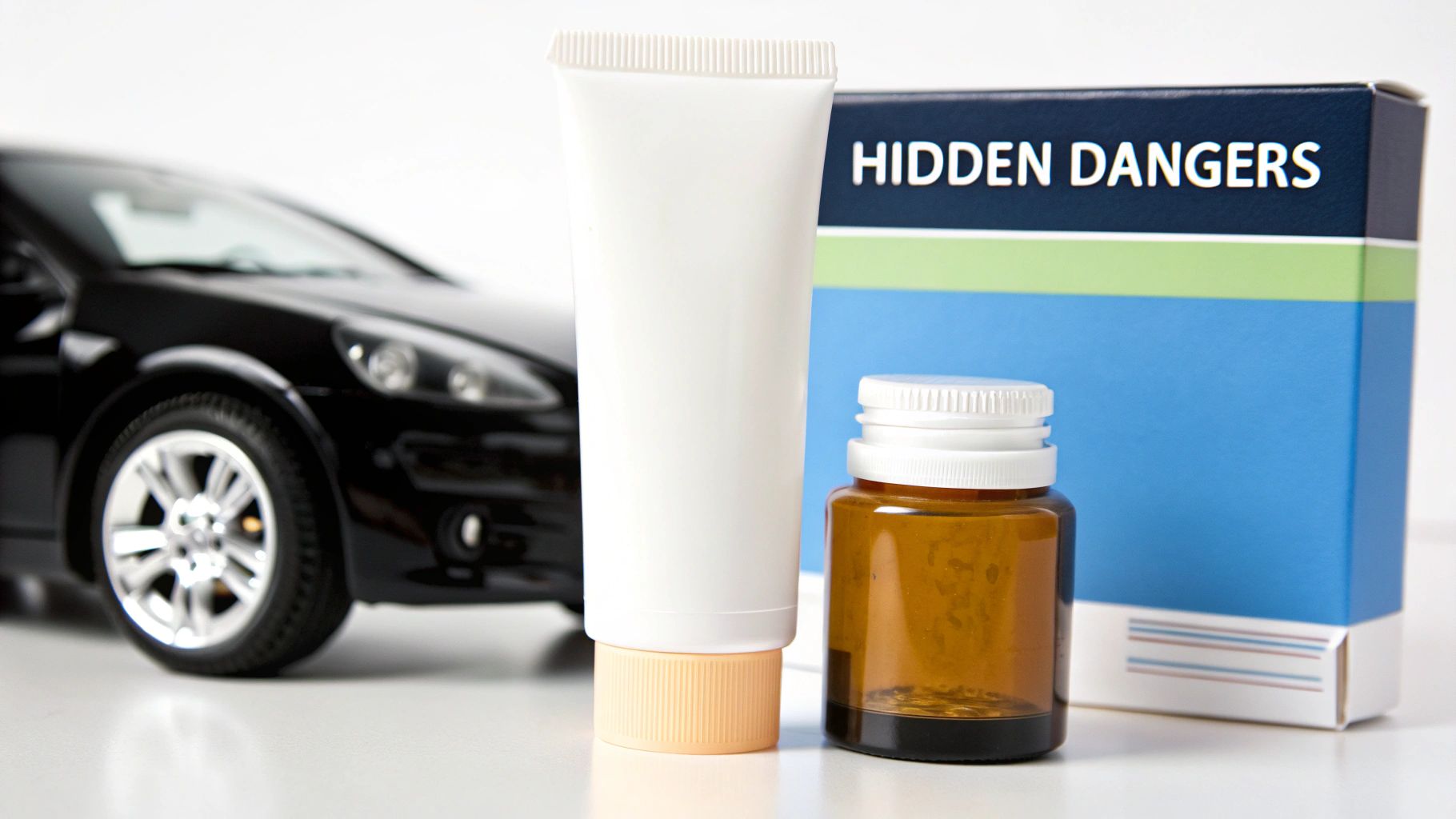
The world of fake goods is a lot bigger than just knock-off handbags. It’s a massive, shadowy industry that has wormed its way into almost every market imaginable, and it carries some serious risks that most of us never even consider. This isn't just about getting a product that feels a bit cheap—it's about the potential for real harm.
Think about it: a skincare product loaded with undisclosed, harsh chemicals or a critical car part that's never seen a safety test. These aren't just hypotheticals; they're the kind of dangerous realities that exist in the counterfeit market every single day.
The True Scale of the Problem
The sheer size of this underground economy is hard to wrap your head around. In 2021, the global trade in counterfeit goods was valued at around USD 467 billion, posing a massive threat to public health and the global economy.
While clothing and footwear are still the most commonly seized items, counterfeiters are getting bolder, pushing into high-risk areas like pharmaceuticals, cosmetics, and even automotive parts. You can dig deeper into these statistics on the global impact of fake goods. This shift makes spotting a fake more important than ever. It's a skill that protects your money and your well-being.
The greatest danger of counterfeit products isn't the money you lose—it's the safety you unknowingly sacrifice. From ineffective medicines to flammable electronics, the hidden costs can be devastating.
Why This Matters for Every Shopper
Counterfeiters have gotten incredibly good at their craft, making it tough for the average person to tell a real product from a convincing fake at first glance. They bank on the trust you have in established brands and popular online stores. This guide is here to give you the tools to look past the surface and spot the subtle, yet critical, red flags that give a counterfeit away.
This is especially true today. The pressure for fast, cheap production has flooded the market with low-cost goods, sometimes blurring the line between fast fashion and outright fakes. For more background on this trend, you can check out our guide on what is fast fashion.
By learning the techniques we'll cover, you can:
- Protect Your Health and Safety: Steer clear of dangerous products that bypass all regulatory standards.
- Save Money in the Long Run: Avoid throwing away cash on items designed to fail quickly.
- Support Legitimate Businesses: Make sure your money goes to the innovators and brands creating quality, authentic products.
Here's a quick reference to help you get started. Keep these common red flags in mind the next time you're sizing up a potential purchase.
Quick Checklist to Spot a Fake
| Area of Inspection | What to Look For (Red Flags) |
|---|---|
| Packaging | Flimsy materials, typos, blurry logos, or poor-quality printing |
| Product Quality | Uneven stitching, cheap-feeling materials, or incorrect colors |
| Logos & Branding | Misspelled brand names, inconsistent fonts, or off-center logos |
| Price | A price that seems "too good to be true" compared to retail |
| Seller | Unofficial websites, temporary online stores, or poor reviews |
This table is just a starting point. In the next sections, we'll dive deeper into each of these areas to give you the expert eye you need to shop with confidence.
Your First Clue Is Always the Packaging
Before you even touch the product itself, the box it comes in can tell you almost everything you need to know. I’ve seen it a thousand times: counterfeiters almost always cheap out on the packaging. It’s expensive and difficult to replicate perfectly, which makes it your first and best line of defense. We're going to move beyond just looking for typos and start thinking like a pro.
The first thing to do is just feel it. How’s the overall quality? Real brands spend a fortune on that unboxing experience. Authentic packaging feels solid, the edges are sharp, and the inserts inside hold the product perfectly snug. Fake boxes, on the other hand, often feel flimsy. They’re usually made from weaker cardboard or thin plastic that gives way too easily.
Look Closer at the Print and Graphics
Now, get your eyes on the printing. Legitimate companies use high-quality printing that produces razor-sharp graphics and perfectly clear text. Fakes? Not so much. They're usually made with cheaper methods, and the difference is obvious once you know what you’re looking for.
Zero in on the logo and any pictures on the box. Do they look a bit fuzzy or pixelated? Are the colors faded, overly saturated, or just slightly off from what you see on the brand's official website? These are huge red flags. Even tiny differences in the font or the exact placement of a logo can give away a counterfeit.
A genuine product’s packaging is a promise of quality. If the box feels cheap, has blurry text, or features a logo that’s just a little bit off, it’s a strong signal that the promise is broken and the item inside is likely a fake.
Counterfeiters really struggle with the fine details. For instance, a fake luxury perfume box might use a font that's almost right but isn't the brand’s unique typeface. On an electronics box, you might see a color gradient that looks splotchy instead of having a smooth, clean transition. These are the little slip-ups that expose a fake.
Check for Security Features and Seals
To fight back against fakes, many brands now build security features right into their packaging. These are your best friend because they are incredibly hard for counterfeiters to copy well.
Here’s what you should be on the lookout for:
- Holograms: A real hologram has a deep, 3D effect that shifts as you move it in the light. Fake ones usually just look like flat, shiny stickers. No depth, no magic.
- QR Codes: Lots of products now have a QR code you can scan with your phone to check if it's real. If the code is a dud, leads to a dead link, or takes you to a sketchy-looking site, you've probably got a counterfeit.
- Seals of Authenticity: Always check for tamper-proof seals. If a seal is broken, looks like it's been peeled off and stuck back on, or is just missing altogether, that’s a clear warning. A real seal is applied cleanly and can't be removed without tearing the packaging.
This kind of detailed check is vital, especially for certain products. When you look at analysis of seized counterfeit goods, you see the same categories pop up again and again: watches, shoes, cosmetics, and electronics. The most common giveaways are always strange packaging, misspellings, and missing security features. You can see a breakdown of the most seized counterfeit categories here.
By taking a few extra moments to inspect these details, you can save yourself a lot of trouble and make sure you're getting what you paid for.
Trust Your Senses to Assess Product Quality
While shoddy packaging can be a dead giveaway, the real cost-cutting for counterfeiters happens with the product itself. They skimp on materials. This is where your own senses—touch, sight, and even smell—become your best tools for sniffing out a fake. A genuine product simply has a look and feel that cheap knock-offs can't replicate.
Getting the item in your hands is often the moment of truth. Brands invest heavily in the quality and finish of their products, and it shows. Fakes are all about quick, easy profit, and the physical shortcuts they take are things you can literally feel.
Electronics and Gadgets
When you're checking out electronics, start with the weight. An authentic smartphone or a pair of high-end headphones has a certain density to it, a solid feel that comes from being packed with quality components. A counterfeit, on the other hand, often feels unnervingly light or hollow. That's a huge red flag for cheap, inferior parts.
From there, get a feel for the build and the controls.
- Buttons and Dials: Give them a press. Do they have a satisfying, crisp click, or do they feel mushy and cheap? Genuine buttons are responsive and fit snugly in their housing, while fakes might rattle, stick, or feel loose.
- Screen Quality: If you can power it on, do it. A counterfeit screen is often a dead giveaway, with dull, washed-out colors, poor resolution, or splotchy, uneven backlighting. It just won't have the vibrant, sharp display of the real deal.
- Seams and Fit: Run a finger along the edges where the casing comes together. On a genuine device, these seams are smooth, tight, and perfectly aligned. Any noticeable gaps, misalignments, or rough edges point to a poorly assembled fake.
This quick visual guide highlights some of the first clues you'll notice, which almost always signal the poor material quality you're about to feel.
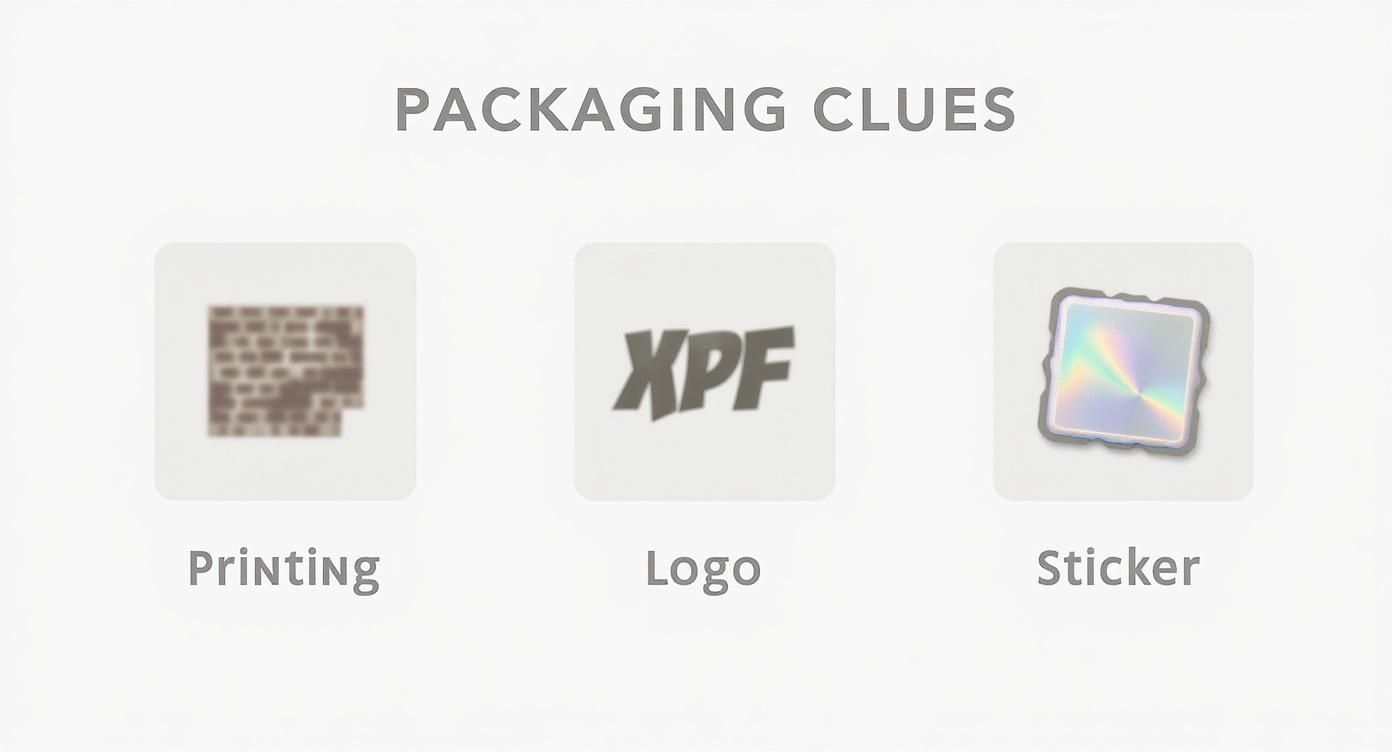
Think of these visual mistakes—bad printing, wonky logos, and flimsy seals—as the opening act. The main event is the subpar physical quality of the product itself.
Clothing and Luxury Accessories
When it comes to fashion—whether it's a handbag, a pair of sneakers, or a jacket—the devil is truly in the details. Counterfeiters are great at copying a design, but they almost always fail to replicate the craftsmanship.
Take a close look at the stitching. On an authentic designer bag, for example, the stitches will be perfectly even, tight, and consistent throughout. Fakes, however, often betray themselves with sloppy, uneven, or frayed stitches, especially in less obvious places like the interior lining.
Authentic craftsmanship is hard to fake. The feel of real leather, the clean lines of a perfect stitch, and the solid click of a well-made clasp are hallmarks of quality that counterfeit products consistently fail to replicate.
The materials are another huge tell. Real leather has a unique, rich smell and a soft, supple texture. Fake "pleather" often reeks of chemicals and feels stiff and plasticky. The same goes for fabrics; high-quality materials have a certain weight and drape, while knock-offs feel thin and flimsy.
And don't forget the hardware. Zippers, clasps, and buckles on genuine products feel solid and heavy, and they operate smoothly. Counterfeit hardware is typically lightweight, looks cheap, and might even be coated in a thin layer of plastic that's ready to chip and flake off.
Here’s a quick breakdown of what to look for across a few common categories.
Authentic vs Counterfeit Quality Comparison
| Product Category | Genuine Product Hallmark | Common Counterfeit Flaw |
|---|---|---|
| Luxury Handbags | Supple, genuine leather; even stitching; heavy, smooth hardware. | Stiff, plastic-like "pleather"; sloppy, uneven stitching; lightweight, flimsy zippers. |
| Smartphones | Solid, balanced weight; crisp, vibrant display; responsive buttons. | Surprisingly lightweight or hollow; dull, washed-out screen; mushy or rattling buttons. |
| Designer Apparel | High-quality fabric with a substantial feel; precise, clean seams. | Thin, flimsy material; frayed edges and loose threads, especially on the inside. |
This table just scratches the surface, but it shows the kind of hands-on comparison that will quickly reveal a fake.
This tactile approach is essential, especially for high-value items. To see these principles in action, this guide on how to spot a fake Rolex in 5 easy steps dives into specific details like weight, magnification, and the distinct sweep of the second hand. By training your senses to notice these subtle differences in weight, texture, and finish, you build an incredibly powerful skill for spotting fakes before you get burned.
Using Serial Numbers to Confirm Authenticity
While packaging and materials can give you a really good gut feeling, the serial number is where the rubber meets the road. Think of it as the product's unique fingerprint. It’s the one thing counterfeiters have the hardest time faking because they can't just invent a code and get it into a company’s official database.
Checking it is often the most definitive way to know if you have a real or fake product on your hands. But first, you have to find it.
Where to Look for the Serial Number
Manufacturers are pretty consistent about where they place these codes, though it varies by product type. Here are the usual spots I check first:
- Electronics: Flip the device over; it's often on the back or bottom. With smartphones, you can also find it in the settings menu under "About" or sometimes finely etched on the SIM card tray.
- Luxury Handbags: Look inside. The number is usually on a small leather or fabric tag sewn discreetly into a seam or an interior pocket. It’s never just floating around.
- High-End Watches: You'll almost always find it engraved on the case back. On some models, it might be hidden between the lugs where the strap connects, or even on the movement itself if the watch has a clear "exhibition" back.
Once you’ve got the number, the real work begins. It’s time to use the brand's own system to expose the fake.
Running the Check Online
Just about every major brand has an online portal for product registration or warranty checks, and this is exactly what you need.
Head directly to the manufacturer's official website—never trust a third-party verification site. Find their support or product registration page and punch in the serial number you found.
If the product is legitimate, the system will recognize it. You’ll likely see details like the exact model, color, and maybe its warranty status. If it's a fake, you’ll hit a brick wall.
A serial number that comes back as invalid, already registered, or linked to a completely different product is the ultimate red flag. This is the clearest, most undeniable proof you're holding a counterfeit.
This quick online check cuts through all the subjective guesswork of inspecting materials and gives you a concrete answer.
The Mismatch Test: Box vs. Product
Here’s another dead giveaway: the serial number on the product itself must perfectly match the one on the box and any included paperwork, like a warranty card. No exceptions.
Counterfeiters rarely bother with this detail. They might print a single legitimate (but stolen) serial number on thousands of fake boxes, none of which will match the actual items inside. Any discrepancy, even a single digit being off, points to a fake.
While you're at it, give that paperwork a closer look. Authentic manuals and warranty cards feel professional—printed on quality paper with sharp text. If you see blurry logos, spelling mistakes, or what looks like a bad photocopy, you can be sure the entire package is a fraud.
Why Where You Buy Is Your Best Defense
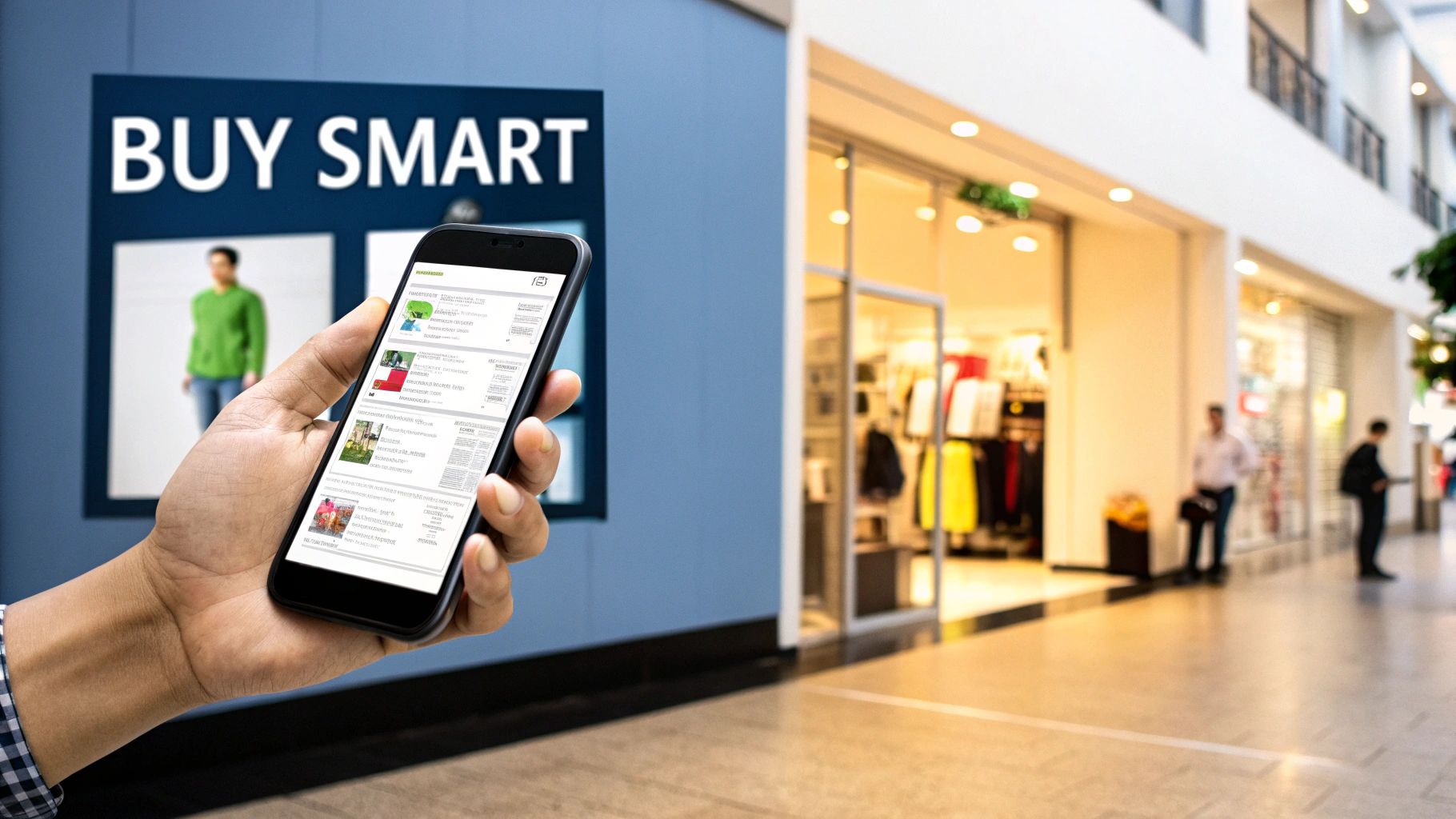
Learning to spot a fake by its packaging or shoddy materials is a great skill to have, but it's a reactive one. The best way to avoid getting duped is to be proactive from the start. Honestly, the single biggest factor in getting an authentic product is simply choosing where you buy it from. Your choice of store is your strongest and easiest line of defense.
Think about where counterfeiters thrive: places with zero accountability and total anonymity. That’s why flea markets, random social media shops, and obscure online marketplaces are such hotbeds for fakes. Sellers can pop up, make a quick buck, and vanish without a trace.
Finding Sellers You Can Actually Trust
The safest route, without a doubt, is to buy directly from the brand’s official website or one of its authorized retailers. Big brands are incredibly protective of their reputation and tightly control who sells their stuff to make sure you get the real deal.
If you’re thinking of buying from an online store you've never heard of, take a few minutes to play detective before you even think about clicking "add to cart." A legitimate retailer’s website should look and feel professional. Here’s a quick checklist:
- Secure Checkout: Always look for "HTTPS" and the little padlock icon in your browser's address bar when you're on a payment page. This means your connection is encrypted and your data is safe.
- Professional Polish: Is the site a mess? Typos, blurry photos, and a clunky layout are huge red flags. Trustworthy businesses invest in their online presence.
- Real Customer Reviews: Reviews can be tricky, but a total lack of them is suspicious. So are pages of nothing but generic, five-star praise. To get better at telling the real from the fake, check out our guide on https://letsparty-au.myshopify.com/blogs/news/how-to-spot-fake-reviews.
Global e-commerce makes things even trickier. Customs reports show a massive surge in seized counterfeit goods, and it's worth knowing where they're coming from. You can learn more about these emerging counterfeit hotspots and trends.pdf) to be a more informed shopper, especially when dealing with international sellers.
The "Too Good to Be True" Price Tag
This is the oldest trick in the book, and it works for a reason. Seeing a designer bag or the latest tech gadget for 50-70% off the retail price is incredibly tempting. But let’s be real—it's almost always a dead giveaway that you're looking at a fake.
Authentic brands enforce strict pricing to protect their value. A massive, unbelievable discount from an unofficial seller isn't you getting lucky; it's a flashing neon warning sign. That low price directly reflects the cheap materials and non-existent quality of a knockoff.
A legitimate business simply can’t offer those kinds of markdowns and stay in business. The price is rock-bottom because the product costs pennies to produce, is made from junk materials, has never been safety tested, and definitely won't come with a real warranty.
So, next time you stumble upon a mind-blowing deal from a seller you've never heard of, stop and ask yourself why. That amazing price is the bait. By sticking to reputable sellers instead of chasing risky discounts, you can shut the door on fakes before they even get a chance to fool you.
Common Questions About Counterfeit Products
Even the most careful shopper can get tripped up from time to time. Let's tackle some of the most common questions and sticky situations people run into with fakes, so you know exactly what to do.
What Should I Do if I Already Bought a Fake?
That sinking feeling when you realize you've been duped is the worst. But don't just chalk it up as a loss. There are concrete steps you can take to get your money back and help stop the seller from tricking someone else.
First things first, contact the seller immediately using the platform where you bought the item. Don't be accusatory, just be factual. Clearly state that you believe the item is counterfeit and you're requesting a full refund. It helps to point out the specific red flags you found, like a serial number that didn't check out or obviously shoddy materials.
If the seller ghosts you or flat-out refuses, it's time to escalate.
- File a claim with the marketplace. Platforms like Amazon and eBay have robust buyer protection policies for a reason, and counterfeit goods are a clear violation. Open a dispute and upload all your evidence—photos are your best friend here, especially side-by-side comparisons with a genuine product if you have one.
- Initiate a chargeback. If you used a credit card, this is your ace in the hole. Call your bank, explain the situation, and tell them you need to dispute the charge because the merchandise was counterfeit. In my experience, credit card companies are very good about siding with the consumer in these cases.
Can I Get in Trouble for Unknowingly Buying a Fake?
This is a common worry, but you can relax. Generally speaking, there are no legal penalties for someone who accidentally buys a fake product for their own use.
Law enforcement's focus is squarely on the big fish—the manufacturers and distributors who are running a criminal enterprise. They aren't interested in the end consumer who got tricked. The real risk to you is the financial loss and, more importantly, the potential safety hazard from a product that hasn't been properly tested. Just remember, knowingly reselling a counterfeit item is illegal, so never try to offload a fake onto someone else.
The core of identifying fakes, whether they are modern electronics or vintage collectibles, comes down to scrutinizing the details that counterfeiters overlook. Authenticity is often revealed in the smallest, most subtle inconsistencies.
This idea isn't new. For a deeper look into how experts in other fields spot imitations, check out these strategies for spotting fake antiques. The underlying principles of meticulous inspection hold true for almost any product.
How Can I Safely Shop on Third-Party Marketplaces?
Let's be honest, third-party marketplaces are a hotbed for fakes, but they also have great deals. You don't have to avoid them completely—you just need to be smart about it.
Always start by vetting the seller. Don't just glance at their star rating; dig into their history and read the actual customer feedback. Are the reviews genuine? Does the seller have a long track record? A brand-new seller with suspiciously low prices is a massive red flag.
When you can, opt for listings that are fulfilled directly by the marketplace (like "Fulfilled by Amazon"). This adds a significant layer of accountability and makes the return process much smoother if something goes wrong.
For a full rundown of best practices, our guide on how to shop online safely is a great resource. By using the product inspection tips from this article and being diligent about who you buy from, you can navigate these platforms with confidence.
At FindTopTrends, we're dedicated to curating a selection of high-quality, authentic products so you can shop with peace of mind. Explore our collections and discover the latest trends without the worry at https://findtoptrends.com.



